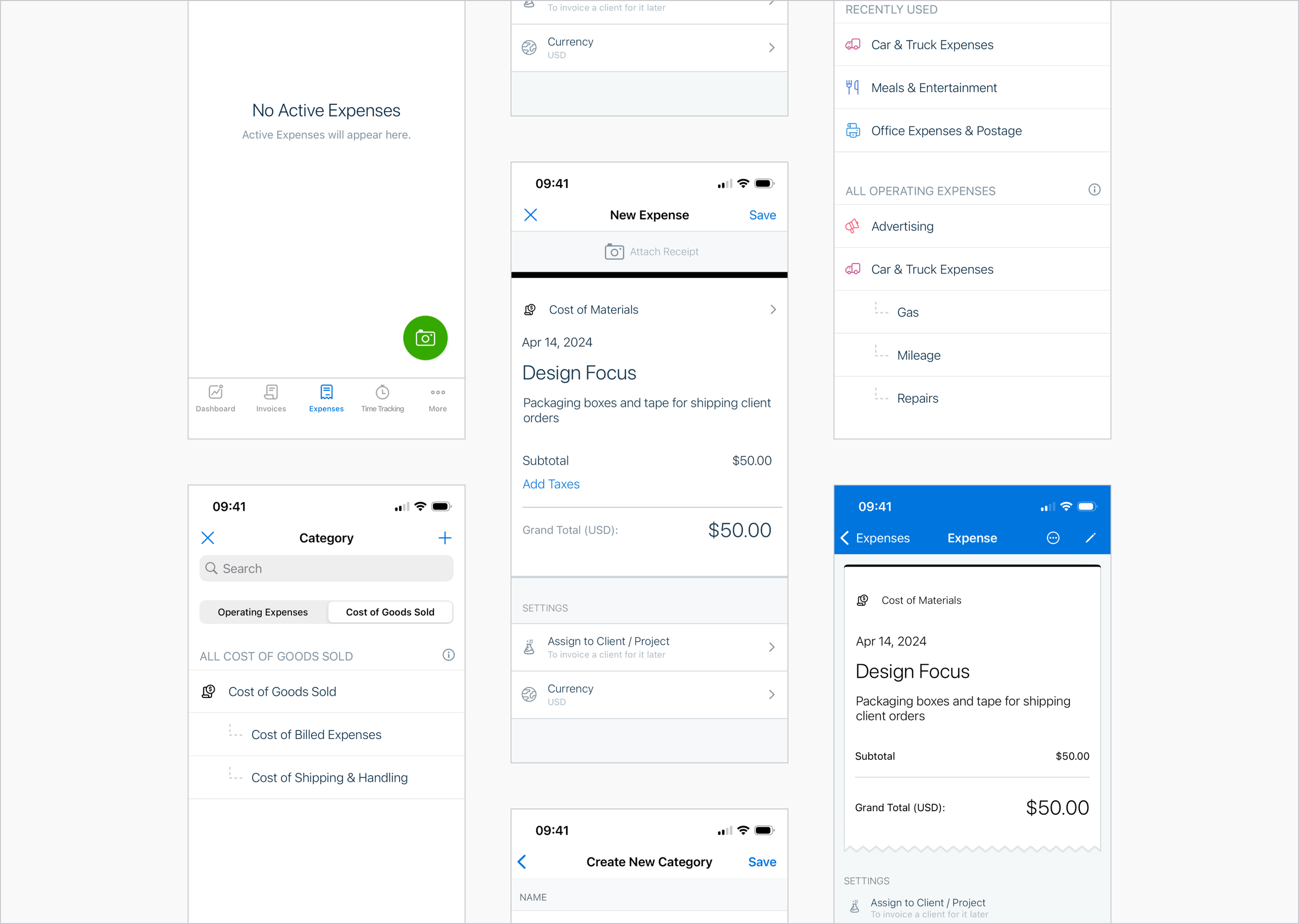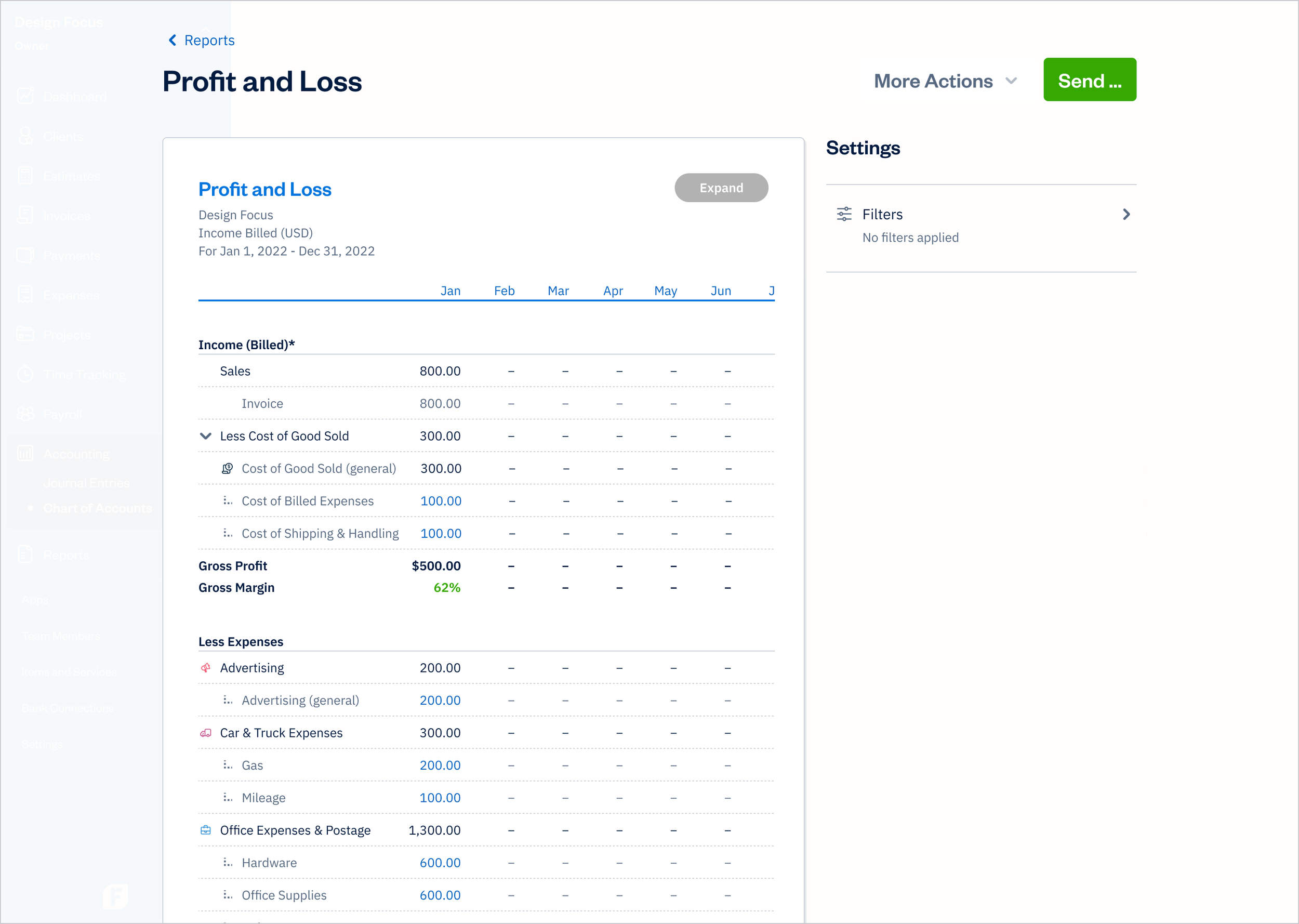Project Overview
Flexible Chart of Accounts
Flexible Chart of Accounts is an comprehensive accounting foundation in FreshBooks that can be customized for the needs of business owners, while keeping accounting user-friendly.
Note: “Flexible” is a name used for project purposes to distinguish between the old and the new functionality. In product, this feature enchancement uses its original name.
Chart of Accounts - Web App
Expenses - iOS App
Feature Explained
What is Chart of Accounts?
A Chart of Accounts is the foundation of the accounting software. Think of the Chart of Accounts as a table of contents or a map of business accounts. It’s a great overview of all accounts to keep business owners organized.
A well designed Chart of Accounts should include all the accounts a company uses to run their business and none of the accounts they don’t need.
At FreshBooks, the CoA impacts multiple product areas, including Expenses, Reports, Bills, and Bank Reconciliation.
-
The Chart of Accounts can look different for every business. Examples:
A fitness studio might show 3 different Income Accounts: Membership Sales, Fitness Class Sales, Product Sales
An advertising agency might have many specific advertising sub accounts including: Podcast Advertising, Online Advertising and Print Advertising
Problem Definition
Not robust, lacks functionality
Previously, FreshBooks only supported default Chart of Accounts. This worked well enough for small business owners, but it did not support the needs of scaling businesses or the accountants that support them.
Problems with the previous CoA
It did not contain accounts used commonly by small and scaling businesses
Owners did not have access to the accounting features and have to create a separate accountant login in order to access them
Owners could not create, edit, archive, delete, or indicate the hierarchy of an account
Owners could not specify accounts at transaction level (expenses)
It did not easily reconcile with reports
UX Strategy
UX strategy
Vision
A platform where small business owners can effortlessly capture their finances, confidently partner with accountants, and gain insight to grow their business, all without having to learn accounting.
Goal
An comprehensive accounting foundation that can be customized for the needs of business owners.
Plan
Give owners access to accounting features only available to accountants, in a user-friendly way.
Process
Design Thinking
The team and I applied a comprehensive Design Thinking approach, collaborating closely to solve a large, complex, and high-impact challenge for FreshBooks.
Discovery
• Analytics review
• UX audit
• User interviews
• Personas
• Journey map
• Competitive analysis
Ideation
• User flows
• Wireframes
• High-fidelity design
Prototyping
• High-fidelity prototype
Testing
• Usability testing
• A/B testing
Implementation
• Final design
• Design handoff
Discovery
UX audit
To kick off the discovery phase, the team and I conducted a UX audit to identify usability and experience issues with the previous CoA.
User interviews
User interviews were conducted with both business owners and accountants. Owners expressed a need for a product that grows with them as their accounting needs change. Most owners that had an accountant had the impression that FreshBooks was not the accountant’s preferred software because of its inflexibility to grow with them.
Note: to protect the identities of participants, generic images/names are used here.
Journey map
Based on a synthesis from the user interviews conducted, I’ve created a journey map that gave a holistic view of the previous accounting user experience by uncovering pain points throughout a series of interactions with the aim to identify opportunities for improvement.
Competitive analysis
Most competitors do offer the abilty for owners to customize their Chart of Accounts, but their accounting functionality isn’t so user-friendly and thus requires accountant’s help. The aim was to identify product-market fit.
Ideation
User flow
When designing the new user flows, I focused on helping users navigate their workflows seamlessly by building on existing functionality while integrating the feature improvements.
Testing
Usability testing
I conducted usability testing with a prototype of the web app, asking participants to complete tasks in CoA, Expenses, and Reports. The goal was to identify potential usability issues and validate our assumptions. Task success rates showed that the new solution is user-friendly, robust, and improves workflow efficiency.
Note: to protect the identities of participants, generic images/names are used here.
A/B testing
To gather quantitative data, I also conducted A/B testing to evaluate the findability of the Cost of Goods Sold category within Expenses, comparing two design variants.
Version A
In Version A, participants had to switch between categories to find Cost of Goods Sold category using a Segmented Control. Although testing showed good findability, we later uncovered significant accessibility issues. The segmented control wasn’t accessible via keyboard since users couldn’t navigate to it using the tab or arrow keys. Screen readers also skipped it entirely, providing no announcement or interaction cues.
Version B - Final
In Version B, participants had to scroll when interacting with a dropdown in order to find the Cost of Goods Sold category. The other option was to search using the input field above. Testing proved that participants found the navigation seamless and easy to use. In the end, we decided to go with this solution due to accessibility issues found in Version A.
Solution
Robust yet simple accounting
A comprehensive accounting foundation that can be customized for the needs of small to scaling businesses, while keeping accounting user-friendly. Flexible Chart of Account is about fortifying FreshBooks’ foundation to scale. Making the foundation more robust and customizable unblocks future accounting features.
Improvements
It now contains accounts used commonly by small and scaling businesses
Owners now have access to the accounting features and don’t have to create a separate accountant login in order to access them
Owners can now create, edit, archive, delete, and indicate the hierarchy of an account
Owners can now specify accounts at transaction level (expenses)
Owners can now create new Cost of Good Sold expense subcategories
CoA now easily reconciles with reports
Owners can now create Journal Entries
Owners can disable these features in Settings > Advanced Accounting
Note: Advanced Accounting and customizable Chart of Accounts are only available on Plus, Premium, and Select plans while Trial users can access the feature for 30 days.
Outcome
Final design
Web app
All product areas that encompass the Flexible Chart of Accounts (i.e., Chart of Accounts, Expenses, Reports) were designed leveraging product’s well established design system. The goal was to uphold consistency and achieve ease of use.
Mobile app
The iOS and Android apps are generally less used for complex accounting workflows, so we chose to exclude certain Flex CoA functionalities from the mobile experience.
However, since Expense categorization is tightly linked to the Chart of Accounts to ensure accurate financial reporting, and because Expenses are is the most used feature on mobile, we decided to introduce the Cost of Goods Sold categorization to the mobile experience as well. This improvement ensures consistency between the web and mobile apps.
The mobile design closely follows Human Interface and Material Design Guidelines, while adhering to FreshBooks’ established design principles.
To see the new and improved Expense categorization design for iOS, you can view the prototype.
Note: the prototype has limited functionality.
Design system
For the Expense dropdown menu in the web app, I improved the design system by introducing headers inside the component. The goal was to visually separate two Expense categories (Operating Expenses and Cost of Goods Sold), and to better organize the information for the scrolling interaction.
Accessibility
By introducing headers in the Expense dropdown menu in the web app, I ensured accessibility in Expenses. The segmented control initially considered had accessibility issues: it wasn’t keyboard-accessible and screen readers skipped it entirely.
The iOS and Android mobile apps use a segmented control, designed to feel intuitive for mobile users while maintaining accessibility.
Design principles
Adapt to the Task
Maintain Flow
Set Expectations
Don't Add, Evolve
Chart of Accounts
Expense Category - Cost of Goods Sold
Expense Report
Profit & Loss Report
Settings - Accounting
Expenses - Cost of Goods Sold - iOS App
Expenses - Cost of Goods Sold - Android App
Impact
KPIs
The feature enhancement delivered a strong impact, evidenced by key metrics and user feedback.
35,000+
MAU (monthly active users)
+44
NPS (net promoter score)
85%
adoption rate
88%
engagement rate
90%
retention rate
How we measured
Adoption rate (85%) was calculated by the proportion of users who enabled Advanced Accounting and upgraded to Plus, Premium, or Select plans after adopting accounting features during their Trial period, since launch.
Engagement rate (88%) was calculated based on users who performed meaningful actions, such as creating, editing, and archiving accounts, as well as creating journal entries, per month.
Retention rate (92%) was calculated as the average percentage of users who continued to actively engage with the Flexible Chart of Accounts features month-over-month since launch, based on usage data since launch.
Net promoter score (+44) was calculated using feedback gathered through Pendo surveys delivered in-app and via email. The majority of respondents gave a 9 or 10, praising the flexibility of the new chart structure, the ease of customizing account categories, and the clarity it brought to their financial reporting workflows.
Customer feedback
“FreshBooks is incredibly user-friendly, especially for small business owners who aren’t accounting experts.”
Sales Marketing Professional | Business Owner
Project Details
Project details
Role: Product Design, User Research
Company: FreshBooks
Team: Product Designer, Product Manager, Engineering
Frameworks: Design Thinking, Agile
Tools:
Design: Figma, Zeroheight, Miro
Project management: Jira, Confluence
Research: UserInterviews.com
Analytics: FullStory, Pendo, Looker
Year: 2022
Platforms: Web, Mobile
Link: FreshBooks.com









